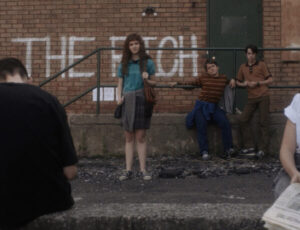You know that you’ve seen a good film when as soon as the credits roll, you want to start it over again to relive the experience. This is how I felt when the closing credits began to roll on How to Survive a Plague, a documentary by David France that focused on the activism surrounding the American AIDS epidemic in the 1980’s. This incredibly powerful documentary is both energizing and educational in its focus on the protest group, ACT UP, and their role in pushing for more HIV/AIDS research and affordable access to available drugs.
How to Survive a Plague has a very raw feeling to it thanks to the excellent crafting of its footage. The film is made up almost entirely of personal recordings of meetings, protests, and home movies, along with archived media appearances and a few present day interviews. The film begins in 1987, with the start of ACT UP (AIDS Coalition to Unleash Power). The group was focused on protest as a means to push for government action and responsibility in the AIDS crisis. Its members came from all walks of life and were united in the common cause to find a cure, or treatment for the virus that was rapidly picking up speed and decimating the gay community. It was clear to the group that bloated government procedures surrounding the testing and production of new treatments would have to be overhauled in order to properly tackle their dire situation. The frustration of the protesters is palpable as they push up against the powers that be to get answers and drugs that will quite literally save their lives. Faced with so many barriers, members of the group, with the help of Iris Long, a retired chemist, started a self-education campaign and began studying all material written on the virus. They familiarized themselves with drugs available in other countries, testing processes, and would eventually write up documents that would help the FDA identify holes in their own research. The film demonstrates the many changes within ACT UP itself, how mounting frustration led to infighting and a group of key members splitting off to create TAG (Treatment Action Group), an organization that was more of a think tank, rather than a protest group. Although the film at times feel repetitive, I believe this simply demonstrates the push and pull that ACT UP experienced with government forces in the struggle to have their voices heard.
France has split his film into a simple, but effective format that details the events of each passing year. Each year is heralded in with a rather grim title card screen that features a counter ticking off the growing number of worldwide deaths due to HIV/AIDS. The aesthetic of these title cards fit the subject matter, with the counter appearing on a grainy colourless image and the ghoulish green text of the flashing numbers reminiscent of a dystopian horror film.
One of the most striking things about How to Survive a Plague is how well it presents the history of ACT UP. Although the film is working with material that has a very high emotional currency, France has the foresight to avoid the pitfall of allowing his story to become too bogged down by personal tragedy. Instead, the film expertly weaves together the group’s activities, accomplishments and struggles, and only occasionally gets closer to the personal lives of certain members such as Bob Rafsky and Ray Navarro, who were among the many that tragically died. This technique allows for France to focus the majority of his energy on the firsthand accounts of ACT UP’s work as a whole, while still showing the human face of those dying from the virus. France has created a gem of a film that pulls back the curtain on an organization whose advocacy created a nationwide focus on HIV/AIDS issues and impacted AIDS research in the United States.








